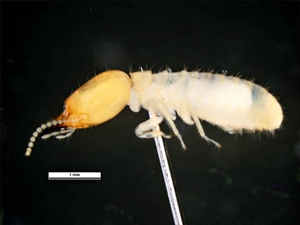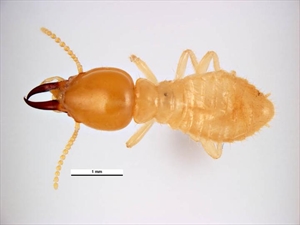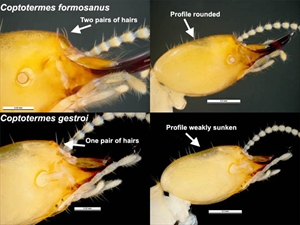Asian subterranean termite
Pacific Pests, Pathogens and Weeds - Online edition
Pacific Pests, Pathogens & Weeds
Asian subterranean termite (384)
Coptotermes gestroi. It was previously known as Coptotermes havilandi.
Southeast Asia, Africa (Mauritius and Reunion), North (Florida and Hawaii), South (Brazil) and Central America (Mexico), Oceania. It has been recorded in Fiji (restricted to Lautoka area, Viti Levu) and French Polynesia (Marquesas Islands).
Apart from sawn timber, they feed on the cellulose in paper, clothes and living trees such as mango, citrus, coconut and cassava. In the West Indies, it is found in natural woodland areas, but in Florida it is restricted to buildings, trees nearby and boats.
The termite prefers timber and to hollow out living or dead trees to build a colony. Mostly, they live underground, but may form foraging tubes on the ground and outside of buildings.
Colonies are produced by a male and female pair (the king and queen), the only members with eyes. The females lay up to a 1000 eggs a day and live for about 20 years. Colonies contain 60,000 to more than 1 million individuals.
Eggs hatch to become soldiers or workers, navigating by scent and moisture trails.
Soldiers are white, about 4.8 mm long, have large heads and jaws that can block the tunnels keeping out invading ants and termites of other species (Photos 1&2). There are two small pale spots adjacent to the antennae. Their heads also emit toxic substances to ward off enemies, from a hole at the front called the fontanelle.
Workers are cream or white, smaller than soldiers, have saw-tooth jaws, and dig tunnels, carry food and care for the young. The king and queen are fed by the workers.
Spread occurs in two ways: At the end of the year (spring in the northern hemisphere) winged 'reproductives' develop and swarm in large numbers in the evening or night before starting new colonies in damp soil or moist timber; once each colony is established (initially by a king and queen), the workers take over, and the soldiers radiate out through the soil to find suitable food. Spread also occurs when colonies are transported by human beings, often in shipping pallets.
Coptotermes gestroi is considered a very destructive termite, second only to Coptotermes formosanus, the Formosan subterranean termite. Worldwide, the costs from the damage it causes, and attempts at eradication or management, are estimated in the several billions of dollars.
Look for signs of termites, i.e., swarms; mud-covered trails over the ground leading to woodwork; sawdust-like powder near doors and windows; shed wings; and holes and raised paint on wood surfaces. Microscopic examination of the number of fine hairs around the fontanelle (a hole in the front of the head) is necessary to distinguish Coptotermes gestroi (one pair) from Coptotermes formosanus (two pairs) (Photo 3). Also, the winged forms of Coptotermes gestroi are smaller, with dark heads.
BIOSECURITY
Countries still free from the Asian subterranean termite should take all practical measures to prevent its introduction.
CULTURAL CONTROL
Fiji has a 3-stage plan to eradicate this termite:
Eradication:
- Surveys to map infested buildings and trees, and to create awareness;
- Containment of the spread, and treatment where infestations occur; and
- Surveillance, and community training to prevent further infestations.
Management once established:
To protect homes, a number of measures have been detailed that concern drainage, ventilation, treatment of timber and what to do if swarms are seen or infestations are suspected for other reasons (http://baf.com.fj/news/asian-subterranean-termites).
The measures are similar to those use against Coptotermes formosanus.
- Do not remove and transport any wooden materials, plants, furniture, personal effects and soil from infested areas;
- Maintain hygiene and cleanliness around compounds and inside the houses. Allow fresh air and sunshine to flow freely. Inspect your homes, trees and compounds thoroughly;
- Water puddles must be drained away from homes;
- Drainage and piping systems need to be cleaned and maintained; any leaks from pipes, roofs, air conditioner condensate, etc. should be repaired;
- Where appropriate windows and curtains should be open during the day to allow light and air into the house.
CHEMICAL CONTROL
The following methods are used to attempt eradication of termites, or to contain colonies:
- Building codes. Check codes regulating treatment of wood in buildings, especially where wood is in contact with soil. In most cases, preservatives are injected into wood under pressure, using copper compounds, borate, and others. There may be regulations, too, for wooden buildings stipulating the height of floors from ground level; air ventilation for wooden floors in concrete buildings; height of ceilings; type of framing timbers, and their priming; and which timbers should be painted to prolong durability.
- Soil treatment: Use insecticides toxic to termites such as synthetic pyrethroids or neonicotinoids as barriers beneath buildings pre-construction or post-construction by drilling and injecting beneath the foundations.
- Baits: Apply chitin synthesis inhibitors to monitoring stations (placed in soil around buildings) when termites are detected or where their presence needs to be monitored. The bait is carried to the colony by foraging individuals. The chemicals in the baits do not kill the termites immediately, but they disrupt moulting. New weather-resistant baits may last 12 months, and initial monitoring is unnecessary. Mostly, these baits with their toxic chemicals are applied and monitored by trained pest control operators.
____________________
When using a pesticide, always wear protective clothing and follow the instructions on the product label, such as dosage, timing of application, and pre-harvest interval. Recommendations will vary with the crop and system of cultivation. Expert advice on the most appropriate pesticides to use should always be sought from local agricultural authorities.
AUTHOR Graham Jackson
Information from Rudolf H Scheffrahn, Nan-Yao Su (2017) Coptotermes gestroi (=havilandi) (Wasmann). Asian subterranean termite. Featured Creatures, Entomology & Nematology. UF/IFAS. University of Florida. (http://entnemdept.ufl.edu/creatures/urban/termites/havilandi.htm); and Biosecurity Authority Fiji. Asian subterranean termites. (http://baf.com.fj/news/asian-subterranean-termites); and Coptotermes gestroi. Wikipedia. (https://en.wikipedia.org/wiki/Coptotermes_gestroi); and from Nan-Yao Su, Rudolf H Scheffrahn (2019) Coptotermes formosanus Shiraki. Featured Creatures. Entomology & Nematology. UF/IFAS. University of Florida. (https://edis.ifas.ufl.edu/pdffiles/IN/IN27800.pdf). Photos 1-3 Walker K (2011) Asian subterranean termite (Coptotermes gestroi). PaDIL - http://www.padil.gov.au.
Produced with support from the Australian Centre for International Agricultural Research under project HORT/2016/18: Responding to emerging pest and disease threats to horticulture in the Pacific islands, implemented by the University of Queensland and the Pacific Community.






